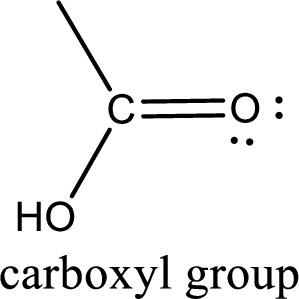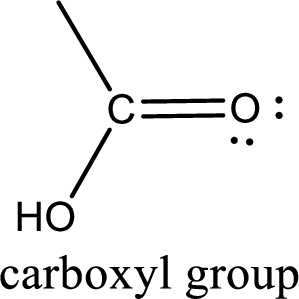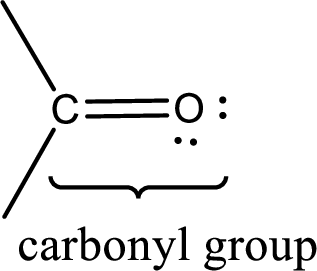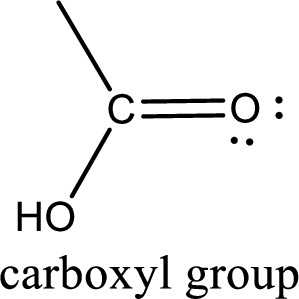
(a)
Interpretation:
Acrylic acid has to be classified among the given options.
Concept Introduction:
Carbonyl groups are the one which contain a double bond between carbon and oxygen atom.

If a hydroxyl group is attached to a carbonyl group means it is known as carboxyl group. This can be represented as shown below,

Apart from carboxyl group, there can be other functional group also that is present in the
(b)
Interpretation:
Maleic acid has to be classified among the given options.
Concept Introduction:
Carbonyl groups are the one which contain a double bond between carbon and oxygen atom. Aldehydes and ketones possess this carbonyl functional group in it. The structural representation of a carbonyl group can be given as shown below,

If a hydroxyl group is attached to a carbonyl group means it is known as carboxyl group. This can be represented as shown below,

Apart from carboxyl group, there can be other functional group also that is present in the carboxylic acid. They are known as polyfunctional carboxylic acids. These occur naturally also. Some of the important type of polyfunctional carboxylic acids are hydroxy acids, keto acids, and unsaturated acids.
(c)
Interpretation:
Succinic acid has to be classified among the given options.
Concept Introduction:
Carbonyl groups are the one which contain a double bond between carbon and oxygen atom. Aldehydes and ketones possess this carbonyl functional group in it. The structural representation of a carbonyl group can be given as shown below,

If a hydroxyl group is attached to a carbonyl group means it is known as carboxyl group. This can be represented as shown below,

Apart from carboxyl group, there can be other functional group also that is present in the carboxylic acid. They are known as polyfunctional carboxylic acids. These occur naturally also. Some of the important type of polyfunctional carboxylic acids are hydroxy acids, keto acids, and unsaturated acids.
(d)
Interpretation:
Caproic acid has to be classified among the given options.
Concept Introduction:
Carbonyl groups are the one which contain a double bond between carbon and oxygen atom. Aldehydes and ketones possess this carbonyl functional group in it. The structural representation of a carbonyl group can be given as shown below,

If a hydroxyl group is attached to a carbonyl group means it is known as carboxyl group. This can be represented as shown below,

Apart from carboxyl group, there can be other functional group also that is present in the carboxylic acid. They are known as polyfunctional carboxylic acids. These occur naturally also. Some of the important type of polyfunctional carboxylic acids are hydroxy acids, keto acids, and unsaturated acids.
Trending nowThis is a popular solution!

Chapter 5 Solutions
Organic And Biological Chemistry
- Classify the two carboxylic acids in each of the following pairs as (A) both dicarboxylic acids, (B) both monocarboxylic acids, or (C) one dicarboxylic and one monocarboxylic acid. 1. Glutaric acid and valeric acid2. Adipic acid and oxalic acid3. Caproic acid and formic acid4. Succinic acid and malonic acidarrow_forwardWhat are the properties of carboxylic acid? What are the steps in the IUPAC and common naming of carboxylic acid?arrow_forwardComplete the table provided below for nomenclature of Carboxylic Acid & Derivatives.arrow_forward
- The IUPAC name for a carboxylic acid with three carbons in a straight chain would be A. propanoic acid B. ethylmethanoic acid C. propanalic acidarrow_forwardCarboxylic Acid Alcohol Ester (Condensed Structural Formula) Odo Formic acid Ethyl alcohol Rum Acetic acid Ethyl alcohol Fruity Acetic acid Isopentyl (isoamyl) alcohol Banana Acetic acid Octyl alcohol Orange Propionic acid Ethyl alcohol Pineapplearrow_forwardWhat is the equation for the dissociation of a carboxylic acid in water?arrow_forward
- Define the structure of a carboxylic acid ?arrow_forwardComplete the table. Questions IUPAC Common name vanilla bean a carboxylic scid used in rubber, textile, dyeing, leather and electroplating industries. used as medicstion and insect repellent. As a medication it is used to treat scabies and lice.arrow_forwardChoose the products that can be made when using an ester as the starting material. You may assume that necessary reagents are present. Choose all that apply. carboxylic acid acid anhydride amide ester alkenearrow_forward
- II: Classify the two carboxylic acids in each of the following pairs as: A- both dicarboxylic acid B. both monocarboxylic acid C. one dicarboxylic and one monocarboxylic acid 1. Glutaric and valeric acid 2. Adipic acid and oxalic acid 3. Caproic acid and formic acid 4. Succinic acid and malonic acid 5. Butyric acid and succinic acidarrow_forwardWhat is the correct IUPAC name of the following compound? Select one: O a. 2-sec-butyl-4,4-dimethylnonanoic acid O b. 2-Isobutyl-4,4-dimethylnonanoic acid O c. 4,4-Dimethyl-2-sec-butylnonanoic acid O d. 4,4-Dimethyl-2-isobutylnonanoic acidarrow_forward1. Give at least four medicinal uses of salicylic acid. 2. What are the roles sulfuric acid in the synthesis of salicylic acid? 3. What are the effects of the carboxyl group to the activity of salicylic acid?arrow_forward
 World of Chemistry, 3rd editionChemistryISBN:9781133109655Author:Steven S. Zumdahl, Susan L. Zumdahl, Donald J. DeCostePublisher:Brooks / Cole / Cengage Learning
World of Chemistry, 3rd editionChemistryISBN:9781133109655Author:Steven S. Zumdahl, Susan L. Zumdahl, Donald J. DeCostePublisher:Brooks / Cole / Cengage Learning Chemistry for Today: General, Organic, and Bioche...ChemistryISBN:9781305960060Author:Spencer L. Seager, Michael R. Slabaugh, Maren S. HansenPublisher:Cengage Learning
Chemistry for Today: General, Organic, and Bioche...ChemistryISBN:9781305960060Author:Spencer L. Seager, Michael R. Slabaugh, Maren S. HansenPublisher:Cengage Learning Living By Chemistry: First Edition TextbookChemistryISBN:9781559539418Author:Angelica StacyPublisher:MAC HIGHER
Living By Chemistry: First Edition TextbookChemistryISBN:9781559539418Author:Angelica StacyPublisher:MAC HIGHER


